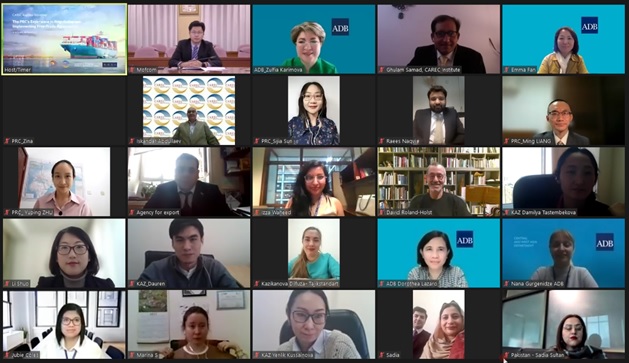CAREC Institute Presents CAREC Trends in the context of FTAs Designing

On November 28, Dr. Ghulam Samad, Senior Research Specialist of the CAREC Institute, presented CAREC regional trade trends at the CAREC Regional Workshop “China’s experience in negotiating and implementing of FTAs”. The workshop was organized by the Ministry of Commerce of the People’s Republic of China, the Asian Development Bank, the CAREC Program and the CAEC Institute. The workshop session was moderated by Dr. Iskandar Abdullaev, Deputy Director Two of the CAREC Institute.
During his presentation, Dr. Ghulam Samad emphasized the consideration of exogenous shocks (COVID-19 pandemic and Russian-Ukrainian conflict) in formulating and designing FTAs. The new generation FTAs should be vigilant to exogenous shocks. Also, designing and formulating holistic and pragmatic FTAs sectoral decomposition of the CAREC economy and trade is extremely important.
The economies of most of the CAREC countries are undergoing structural changes in which the share of the service sector is increasing, and the share of agriculture is declining. Despite the increasing share of the service sector, regional trade in services is less developed. Further decomposition of service exports in CAREC countries shows the dominance of transport and tourism services, followed by other business services. The trade in digitally deliverable services is not developed in many CAREC countries. The sectoral decomposition also shows that many CAREC countries’ exports are less diversified and still focus on relatively few commodities. This decomposition helps to understand the sectors most affected by exogenous economic shocks and to identify sectors that create and divert trade.
Dr. Ghulam Samad noted the dominant role (achieved mostly after signing FTAs) of the PRC in trade, not only in the CAREC region but also in the world. China’s trade volume in 2021 was $6,037.5 billion, with a trade surplus of $686.1 billion. In 2021, China exported goods worth $3,361.8 billion to the world and imported goods worth $2,675.7 billion. China’s total trade with the CAREC region was US$66.1 billion, including US$46.2 billion of exports to CAREC countries and about US$20 billion of imports from CAREC countries. China dominates trade with Kazakhstan: China exports $12.6 billion worth of goods to Kazakhstan and imports $8.58 billion worth of goods and services from Kazakhstan. Pakistan is the largest importer from China among the CAREC countries ($15.9 billion).
The CAREC region as a whole imported US$2,812 billion worth of products from the world in 2021, up US$594 billion from 2019 imports, while it exported US$3,446 billion worth of products to the world, up $808 billion from 2019 exports. The PRC plays a very dominant role in the CAREC region — about 95% of the region’s products are imported and 98% of the region’s products are exported by the PRC. Exports from CAREC countries, especially landlocked countries, have stagnated over the past few years. For several countries in the CAREC region, the trade balance was negative for many years. The main barriers to intra-regional trade are related to underdeveloped infrastructure and the structures of economies.
Dr. Ghulam Samad noted that CAREC’s connectivity is critical to establishing regional cooperation mechanisms such as policy coordination, cross-border trade, and the integration of regional networks to achieve economic goals. The expansion of the range of trade products and services requires decisive action in the areas of policy coordination, transparency and business reform, cross-border trade and regional networks. Dr. Ghulam Samad proposes to deepen and expand regional cooperation through opening service markets, knowledge sharing, policy harmonization, and coordinated infrastructure development.